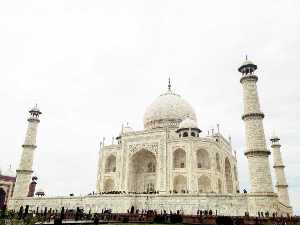Entry Fee : Indian Citizens and Visitors from SAARC countries: INR 50
Citizens of SAARC and BIMSTEC Countries: INR 540
Foreign Visitors: INR 1100
(Additional INR 200 for every tourist who wishes to enter the mausoleum)
Entry is free for all children below 15 years
Citizens of SAARC and BIMSTEC Countries: INR 540
Foreign Visitors: INR 1100
(Additional INR 200 for every tourist who wishes to enter the mausoleum)
Entry is free for all children below 15 years
Taj Mahal, Agra Overview
What is widely considered as the most beautiful building in the world, Taj Mahal is located in the historical city of Agra. It was built by the Mughal Emperor Shah Jahan as a memorial for his third wife, Mumtaz Mahal. Constructed entirely out of white marble in the 17th century, it is among the finest edifices of Mughal architecture. Recognised by the UNESCO as a world heritage site, this monument is also considered to be one of the seven wonders of the modern world. Every year visitors numbering more than the entire population of Agra pass through the magnificent gates to catch a glimpse of this breathtaking monument, and only a few leave disappointed. Shah Jahan said about the Taj that it made "the sun and the moon shed tears from their eyes".
The Taj Mahal stands for the Crown of Palaces in the Persian language. It rises from the dust-beaten earth of Uttar Pradesh, but even the wildest imaginations leave visitors underprepared for this world wonder. Covering an area of approximately 42 Acres, the Taj Mahal was constructed using white marble obtained from Makrana in Rajasthan.
Rabindranath Tagore described it as "a teardrop in the cheek of eternity" while Rudyard Kipling said it is "the embodiment of all things pure". The construction of the Taj Mahal began in 1631 and took 17 years before it was completed in 1648! The tomb is laid out in a rectangular shape and can be approached through a massive gateway which has an arch and alcoves on either side of it. The Taj, so majestic from the exterior, has equally splendid artistic work done in the interiors. There are water channels and fountains in the entrance which makes the monument even more spectacular. The reflection of this majestic spectacle in the Yamuna is almost poetic in its perfection!
Rabindranath Tagore described it as "a teardrop in the cheek of eternity" while Rudyard Kipling said it is "the embodiment of all things pure". The construction of the Taj Mahal began in 1631 and took 17 years before it was completed in 1648! The tomb is laid out in a rectangular shape and can be approached through a massive gateway which has an arch and alcoves on either side of it. The Taj, so majestic from the exterior, has equally splendid artistic work done in the interiors. There are water channels and fountains in the entrance which makes the monument even more spectacular. The reflection of this majestic spectacle in the Yamuna is almost poetic in its perfection!



Comments
Post a Comment